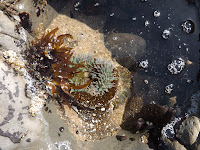As far as I know, there is only one redwood tree on campus that survived the wholesale clear-cutting of yesteryear.
Natural History pinpoints the location of this "old-growth" tree (people commonly use "old-growth" when referring to trees that were here before loggers ravaged the forest, but technically the term refers to forests rather than individual trees; an old-growth forest has characteristics like downed snags, old trees, etc.) near the Porter Provost's house. Once you see it, it's obvious why the timber barons weren't interested: the tree is gnarled, twisted and short; its crown seems to have died long ago and partially fallen off. But the hardness of the bark and the impressive width of the tree tell you it's been there a long time.
The tree is hard to climb, and the top doesn't even offer a good view because the much younger surrounding trees have all managed to grow taller - they don't seem to have the mutation that causes twisting, intense burling, and other qualities which seem to limit this old redwood's height. Several features make this tree interesting, however.
About 15 to 20 feet up are two reiterated trunks. Reiteration is a phenomenon that causes redwoods (and other trees, too) to sprout an extra trunk on a limb or a part of the trunk that has been damaged. Redwoods can also send up new trunks in response to new openings in the canopy, and I am not sure if damage is a prerequisite in these cases. Twisted, gnarled redwoods seem to be particularly prone to reiteration, and this one at Porter College is a good example. Near these two reiterations is a pile of raccoon droppings, and near the dead top of the tree, among the ubiquitous holes full of nuts, is a fire cave where raccoons live.


Moving on. Pogonip City Park has a whopping four redwoods from before the clear-cutting, according to
this entry on the College Eight Core wiki. Last Fall my friend Jessica showed me one of them, a spectacular specimen near the koi pond. It is gnarled and twisty (again, probably the reason it was spared the axe) and full of reiterations. If you don't want to go to the trouble of getting a rope over one of the reiterations, several burls make it possible to climb into the lowest reiteration, and from there the rest of the tree is accessible. Up toward the top, mosses and lichens start growing in abundance, and the top offers a beautiful view of Santa Cruz, the bay, and Monterey.
 |
| The old redwood we found today. |
That leaves three old redwoods in Pogonip. Wesley and I found one of them today, following a map from a book about the city park. We stumbled down a grassy slope just east of Lower East Field and, after a couple wrong turns, found the tree. It grows right next to the path and is recovering from what looks like a recent fire. Almost the whole trunk is charred, and many of the leaves near the top of the tree are dead because the fire destroyed the connection between the roots and the top of the tree. Redwoods are spectacular fire-resistors, however, and the tree is on the rebound.
 |
| Wesley rocking the ascenders. |
As expected, it is short and gnarly. The top has been hollowed out by fire, and at the base of the tree is the stump of what was formerly the tree's second trunk. This second trunk is lying next to the surviving part of the tree; it looks like it was leaning so far over the path that the city decided to cut it down for safety reasons. Considering that loggers have already chopped down over 95 percent of the old redwoods, it really doesn't make sense to chop down any more. This gnarled, burly tree, however, doesn't seem to have much to contribute to the future redwood gene pool.
 |
| A woodland cicada at the base of the tree. |
 |
| The hollowed-out top and an arboreal primate. |
 |
| From the ground. |
The map from the aforementioned book on Pogonip points out one other old redwood nearby that we didn't go to today. That leaves one ancient individual hiding in the forest. Where could it be?






















































